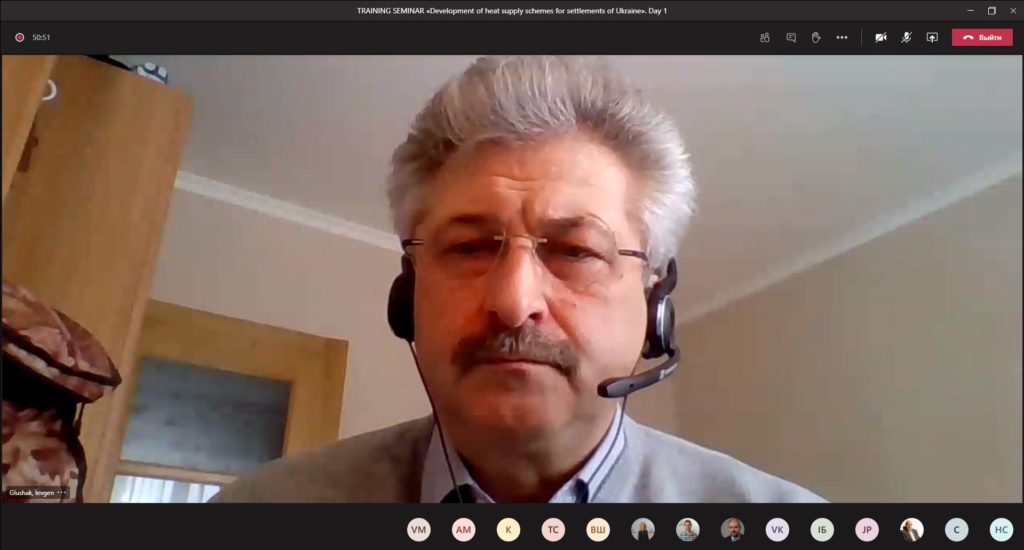On February 18-19, 2021, the USAID Energy Security Project (ESP) conducted the training workshop “Development of Heat Supply Systems for Ukrainian Localities” for the Kropyvnytsky heat supplying company KP Teploenergetyk, the Kropyvnytsky City Council, and heat supply system development experts from different cities of Ukraine. The purpose of the workshop was to help in developing heat supply systems under a new method. Workshop participants learned about the method’s structure and conceptual provisions, current district heating problems, and European heat supply development trends.

USAID ESP district heating expert and leading research scientist at the National Academy of Science’s Gas Institute of Ukraine Ievgen Nikitin said the new method will improve the quality and reduce the cost of district heating services. It is particularly relevant under the current conditions, when Ukrainians often switch to individual heat supply in search of cheaper energy sources.
The experts focused on how to make district heating more competitive and how to ensure its sustainability as an environmental and energy security element. In fact, the reason why EU countries implement district heating is rather straightforward: it is an environmentally-friendly, secure source of heat supply that enables balancing the generation of renewables.
Although the workshop discussion mainly concerned Kropyvnytsky, the experts provided universal advice as most Ukrainian cities are in a similar situation. USAID ESP recently signed a memorandum of cooperation with the Kropyvnytsky City Council and KP Teploenergetyk that envisages improving the city’s heat supply system.
The current European district heating trends envisage replacing conventional sources, and they should be considered when developing heat supply systems for Ukrainian cities. As the experts observed, the fundamental difference in the new method is the target indicators in the Terms of Reference: what will be improved and how, and whether the tariff will be reduced. Additionally, the method requires identifying financing sources and conducting an environmental impact assessment. Energy management and energy auditing will play a significant role that will enable considering changes in buildings’ characteristics.
The workshop participants learned about the problems developers of efficient heat supply systems should help to resolve in the modernization of energy sources: modernizing gas boilers and other equipment, switching to alternative energy sources, implementing cogeneration, optimizing heat networks where main heat losses occur, modernizing the hot water supply system, and forecasting heat load.
Sergii Gorbachov, USAID ESP Deputy Chief of Party, said, “The unique opportunity to model both the gas distribution system and the heat supply system allows us to assess heat demand optimization and the impact on heat supply sources. USAID ESP can propose and proposes systemic steps. Improving energy efficiency should precede the planning and modernization of heat supply.” He also expressed confidence that installing individual heat supply stations is beneficial to both companies and customers.
For his part, Ievgen Glushak, USAID ESP Heat Market Officer, added that in cities where district hot water supply was somehow terminated, the corresponding networks were irretrievably lost. “A simple ferrous metal pipe is used for supplying hot water. Its lifetime for hot water supply is from 10 to 15 years, but it must be constantly filled with water to prevent oxygen penetrating into the pipeline. Under the classic form of district heating, full re-laying of the lines and building all new heat supply networks are required. Therefore, the only solution is to switch to individual heat supply stations,” the expert said.
During the workshop, participants paid special attention to the benefits of distributed cogeneration (proximity to energy customers, reduction of modernization costs, high flexibility, increased energy level at localities, relatively small one-time investments) and alternative energy sources, such as solid domestic wastes (SDW), landfill gas from SDW sites, bio-fuel (waste wood, pellets, agricultural processing waste, energy plantations), and even the silt of sewage effluents.
In his presentation, Volodymyr Galaniuk, representative of the Reform Office at the Ministry for the Communities and Territories Development of Ukraine, remarked that heat supply issues should be considered together with cooling issues. According to him, as far back as in 2016, EU countries developed a complex assessment of prospects for heat supply and cooling in localities, which included a section on demand forecasting. Most EU countries forecast reduced heating demand (explained by thermal insulation in buildings) and although several countries forecast an increase in heat demands, they all are unanimous concerning an increase in demand for building cooling in the summer period. “District heat supply and district cooling in Europe are considered as a package, and designed and built together,” Galaniuk stressed.
Summarizing conclusions from the workshop, Ievgen Glushak, USAID ESP Heat Market Officer, emphasized that the heat supply system was a result of extenive work on preparing the Terms of Reference. He stated that data are now being extensively collected and work will begin shortly to prepare the Terms of Reference for developing Kropyvnytsky’s heat supply system. “The Terms of Reference for developing a heat supply system is the sole responsibility of the city’s representatives and the whole community is the owner of the system. One of the most important stages in preparing the Terms of Reference is an audit of the load connected to the heat network, which they should conduct,” he added.
Slides targeting Ukrainian heating utilities are available in Ukrainian only.
